Early disease detection can be critical to living a longer, healthier life.
Take cancer, for example, when detected in the early stages, the survival rates are significantly higher than in the late stages
However, around 50% of cancers are detected in late stages, which lowers the chances of positive outcomes1Early detection of cancer | Crosby, D et al. | 2022 | Science.

Full-body MRI (Magnetic Resonance Imaging) scans are a powerful tool that can be used to detect cancers, aneurisyms and other health conditions.
Used pro-actively, they could help detect disease in it’s early stages.
In this article, we will compare the most prominent whole-body MRI scan options in the US. That includes a detailed comparison of Prenuvo, Ezra, and SimonOne.
How Do Full Body MRI Scans Detect Cancer and Other Conditions?
MRIs use strong magnetic fields and radio waves to generate detailed images of the internal body structures. Unlike X-rays or CT scans, MRI scans don’t involve ionizing radiation, making them safer for repeated use.
So, how does a whole-body MRI work?
The process begins with the patient lying on their back and sliding inside a cylindrical machine that contains a powerful magnet.
The magnetic field temporarily aligns hydrogen atoms in the body. The machine then sends brief radiofrequency pulses that move the atoms to higher energy states. Once the pulses end, atoms return to their previous state, emitting radio waves in the process.
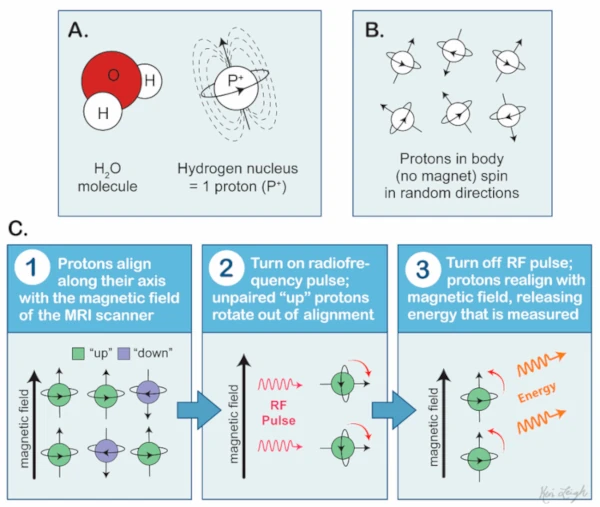
Based on the specific signals, the MRI machine can identify atom positions and distinguish different types of tissues. It uses this information to create detailed cross-sectional images of the body’s interior.
MRI scans are great at differentiating between different types of soft tissues, such as muscles, organs, and tumors. Any tissue differentiation or abnormalities can be seen on the scan.
A medical professional reviews these images to detect tumors, cancers, aneurysms, vascular conditions, and other abnormal growth patterns. This facilitates early diagnosis when treatment is the most effective.
Comparing Full Body MRI Scans in the US
Although MRI was introduced as a diagnostic tool in the early 1980s, the technology has significantly improved in the last two decades2MR Imaging in the 21st Century: Technical Innovation over the First Two Decades | Kabasawa, H | 2022 | Magnetic Resonance in Medical Sciences.
Today, full-body MRI scans are more accurate and valuable than ever.
In this section, we want to compare the three most reputable whole-body MRI options in the US: Ezra, Prenuvo, and SimonOne.

Basic Information

Ezra is a healthcare AI startup that provides MRI scans at affordable prices. The goal is to detect cancers early and increase the chances of positive outcomes for people battling this condition.
According to the company’s mission statement, they have already helped 13% of their members detect potential cancers early. Their objective is to make full-body MRIs a part of regular health check-ups and scan one million people by 2030.
Ezra scans 13 organs for cancers and over 500 different conditions. They have three options: Full Body Flash, Full Body, and Full Body Plus scans.
You can also take an online quiz to get a quick estimate of your risk of developing cancer. There, you answer questions about your medical history, lifestyle, and family medical history.
The result is displayed on a scale of 1-100, with higher numbers representing the increased chances of developing cancer. You also get a risk assessment for major organs that looks like this:
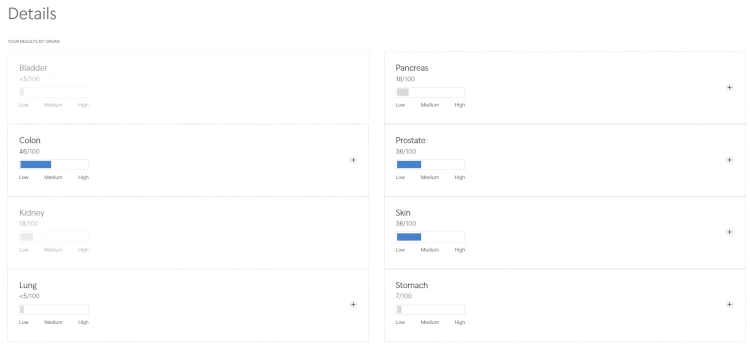
The company provides recommendations on what lifestyle changes you can make to lower the risk of developing specific cancers. For example, if you have the highest risk of developing colon cancer, you may receive recommendations that look like this:
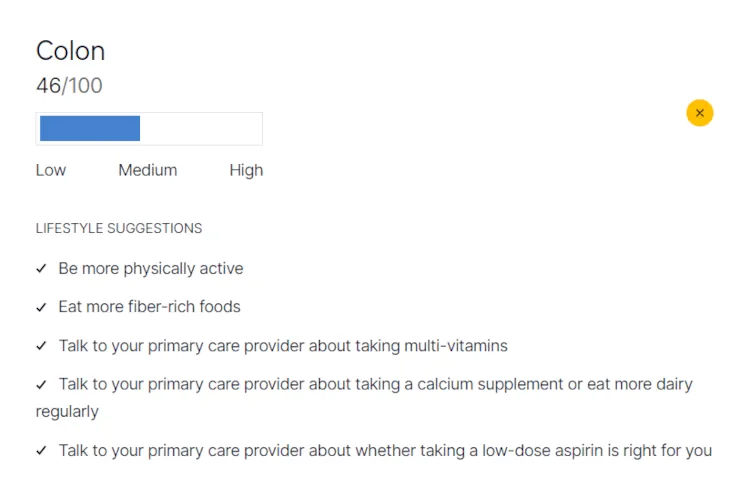

Prenuvo is a healthcare company that offers whole-body MRI scans for early cancer and disease detection.
The company was co-founded by an engineer called Raj Attariwala, who has a PhD in Biomedical Engineering with a double residency in Nuclear Medicine and Radiology.
Rather than take an off-the-shelf MRI scanner, he has worked with manufacturers to procure custom MRI scanners specifically for the task (discussed briefly in his interview with Peter Attia). They combine it with custom software to maximize the task-specific performance they want.

Prenuvo manages to get a detailed scan of the whole body in just one sitting, enabling early detection of abnormalities. The MRI covers 26 different regions or organs, supporting the detection of over 500 conditions (according to their site).

Lastly, we have SimonOne, which offers affordable full-body MRI scans covering all major organs and over 100 body structures. These scans can detect abnormalities and early-stage diseases, reducing the chances of negative health outcomes.
SimonOne scans also include magnetic resonance angiography (MRA), which creates images of arteries, veins, and blood vessels. That helps identify stenosis, aneurysms, and other abnormalities of the circulatory system.
Although Prenuvo doesn’t explicitly mention it, I emailed them about the use of MRA technology and they have confirmed that their whole body scan also includes the MRA of the brain.

Scan Technology (inc. 1.5T vs 3T)
Prenuvo’s MRIs use customized 1.5T magnets, carefully balancing the trade-off between imaging quality and patient comfort.
This is in contrast to Ezra and SimonOne’s use of off-the-shelf 3T scanners.
There are pros and cons to both scanners, but overall 1.5T comes out favorable for full-body scans.
Pros of Prenuvo’s 1.5T MRI scanner approach
- ✅ The lower power magnet produces less heat in the subject who’s being scanned, so it physically feels more comfortable to them.
- ✅ Whilst both 1.5T and 3T magnets can be used with implants, some implants will only be rated safe up to 1.5T (source).
- ✅ 1.5T magnets provide images of the abdomen that are less likely to contain artifacts. This is important because the abdomen is the majority of the scan, and therefore you want maximal accuracy for its imaging. See the 3T cons section below for more details.
- ✅ Prenuvo is using custom specifications for their scanners, as opposed to the off-the-shelf scanners that Ezra and SimonOne use. Additionally, these scanners are not used for routine checks, therefore they can be specified and customized to focus solely on whole-body MRI scans.
Cons of Prenuvo’s 1.5T MRI scanner approach
- ❌ 1.5T magnets do not provide the same resolution of imaging, which is particularly useful when it comes to the brain.
Pros of 3T MRI scanners
- ✅ 3T magnets provide higher resolutions, which may be particularly useful on brain imaging scans.

Cons of 3T MRI scanners
- ❌ Whilst 3T magnets can do higher resolution scans, the trade-off is that they are more prone to what are called “artifacts”. Specifically:
- Susceptibility to artifacts caused by fluids or any type of motion including flowing blood or pulsation of cerebrospinal fluid.
- Artifacts are also possible from gas in the bowel which can obscure surrounding organs
- The “dielectric effect” where areas of the image are dark due to the wavelength of radiofrequency used in 3T imaging.
- See this study and specifically, Appendix 1 Table 11 for a more detailed explanation.
- ❌ Some implants are only rated to 1.5T, so owners of those implants shouldn’t use a 3T scanner.
- ❌ The larger the magnet, the more heat is produced, so a 3T scanner can be less comfortable than 1.5T
Further Scan Differences
Their unique protocols include a comprehensive set of filters, minimizing false-positive findings.
Ezra offers several scan options:
- Full Body Flash Scan – Uses FDA-approved Ezra Flash AI for quick image acquisition.
- Full Body Scan – The most popular option that includes spine imaging.
- Full Body Plus Scan – Includes a low-dose chest CT scan for lung abnormalities.
Combining MRI and CT scans improves the screening capabilities, especially for specific abnormalities like lung lesions. However, it does come at the cost of ionizing radiation from the CT. Ezra then uses AI to improve the MRI image quality.
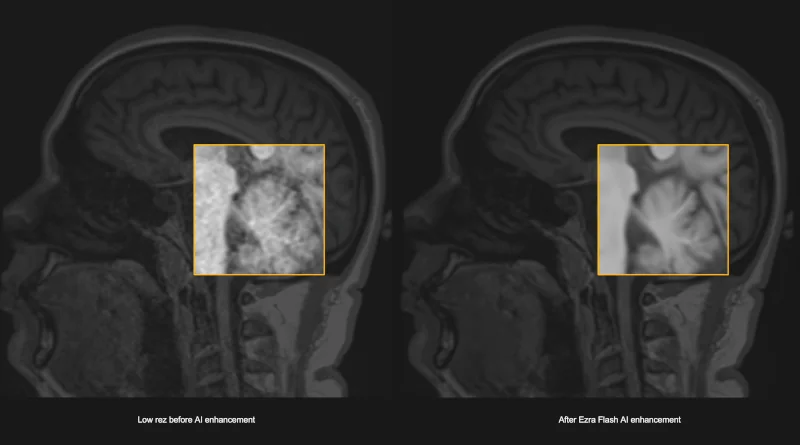
SimonOne employs a comprehensive screening approach, leveraging MRI and MRA. The company uses 3T magnets, similar to Ezra.
Although specific details about their technology are limited, SimonOne’s Body and Body Plus scans cover major organs, and over 100 body structures, and include specialized screenings based on gender.
The company’s focus on neuroimaging and gender-specific screenings adds a layer of specialization to its whole-body MRI services.
Scan Area
Ezra’s full body scan focuses on these organs:
| Brain | Lungs | Spine | Thyroid |
| Pancreas | Kidneys | Liver | Spleen |
| Gallbladder | Bladder | Adrenal Glands | Uterus |
| Ovaries | Prostate |
The scan doesn’t cover the lower and upper extremities, breasts, and heart.
SimonOne’s approach extends from the head through the pelvis, encompassing all major organs and examining over 100 body structures. Their Body Plus option includes NeuroQuant and MRA of the head and neck, along with gender-specific screenings for prostate cancer in men and comprehensive screenings of female reproductive organs.
However, SimonOne does not perform imaging of the upper and lower extremities.
In comparison, Prenuvo offers the most comprehensive screening designed to cover the whole body, from head to toe. Prenuvo scans 26 organs in one session, providing a comprehensive view for early detection of diseases and abnormalities.
Their focus on multiparametric imaging ensures detailed assessments of the brain, arteries, fat, and various cancer screenings. The spinal screening further improves the depth of Prenuvo’s full-body MRI scans.
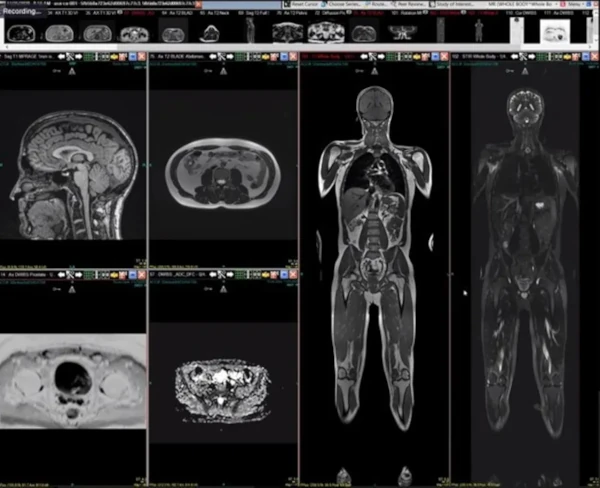
Scan Duration and Comfort
Ezra’s full-body MRI scan lasts around 60 minutes. The machine is wide, which makes the experience more comfortable. However, the head remains inside the machine, which could be unpleasant for claustrophobic people.
Earplugs are provided to minimize noise, and some locations offer headphones with customizable music options.
A Prenuvo scan also typically takes 60 minutes, but what sets it apart is the design of the MRI scanner. Prenuvo’s scanner allows the patient’s head to remain outside the machine for a significant portion of the imaging session.
The wider and more comfortable machine aims to ease the claustrophobic experience commonly associated with traditional MRI scans. For those with claustrophobia, Prenuvo offers the option of a mild sedative, improving overall comfort.
SimonOne’s Plus scan lasts around 45 minutes. The MRI machine’s notable feature is its open design on both ends, contributing to a less claustrophobic and more comfortable experience.
Price Point and Insurance Coverage
| Company | Ezra | Prenuvo | SimonOne |
| Scan Type | Full Body Scan Plus | Whole Body Scan | SimonOne Body Plus |
| Price | $2500 | $2500 | $1250 |
| Insurance Coverage | Not included in any health plan. Ezra offers discounts for multi-year, couple, or family plans. There’s an insurance-related discount for mammograms. | No insurance coverage. | No insurance coverage, but HSA and FSA approved. |
Access to Results and Result Interpretation
Ezra provides a user-friendly hub for patients to access results and reports conveniently. On average, members receive their scan report within five business days. The interpretation of results is conducted by Ezra radiologists, with available telehealth consultations for discussion and further steps.
Prenuvo offers an app and dashboard to easily access results and reports, which are shareable with healthcare providers. Reports are generally created within 10-15 business days. Prenuvo radiologists review the results, and you can schedule a virtual appointment to discuss them.

SimonOne provides a patient portal for storing and accessing results and reports. Reports are typically available within five to seven days. Each report is reviewed by two board-certified radiologists specializing in specific areas, and findings are discussed with patients.
Telehealth consultations are authorized for comprehensive result discussions and preventive care planning.
Roundup
For us to ascertain what the best offering is, we could imagine 2 very important criteria:
- Total body coverage – with more coverage increasing the odds that nothing is missed.
- Sensitivity & Specificity – the accuracy to which an MRI, and its interpretation, can detect whether someone has, or does not have a disease. Including the false-positive and false-negative rate.
To compare these metrics scientifically, we’d likely need a study that compares the different MRI types over time, whilst tracking disease and disease outcomes.
Unfortunately, in the absence of that, the best we can do is to list out the pros and cons:

| Ezra Pros |
| ✅ At the time of writing their scans can be accessed from 18 locations. Although this is limited to the states NY, NJ, LA, SF, Mimia, and Vegas. ✅ They use 3 Tesla magnets which can get more detailed scans of the brain. |
| Ezra Cons |
| ❌ They don’t own their imaging centers, which may have at least 3 impacts. Variance in the scanners used, variance in the specific expertise of the radiologists, variance in the comfort level of the experience. All 3 are easier to control when you own the image center. ❌ Their use of 3 Tesla magnets may not provide the best imaging of the torso. |

| Prenuvo Pros |
| ✅ They own all their imaging centers, except for 1 in Minneapolis. ✅ Their imaging centers all use their own custom hardware (MRI scanners), rather than a mix of different types. ✅ Their radiologists spend all their time interpreting full body scans, and aren’t also doing routine diagnostic scanning (e.g. knees and shoulders), so they are focused and specialized. ✅ They go a long way to make the experience relaxing and comfortable, this can be particularly useful for those with claustrophobia. They also offer a light sedative in cases where it may be needed. ✅ Their use of a 1.5 Tesla magnet in the MRI machine means that they can provide better image quality for torso scans. It also doesn’t heat the patient as much as 3 Tesla magnets. |
| Prenuvo Cons |
| ❌ Price – Whole body scans are $2,499 at the time of writing. ❌ Limited Locations – Whilst at the time of writing Prenuvo has 8 US locations, with 8 more in the works, this does mean they’re not available everywhere, and thus some travel may be needed. ❌ Whilst their 1.5 Tesla magnet has some pros (mentioned above), the downside is that it doesn’t provide high-quality brain imaging. They argue this doesn’t interfere from a diagnosis perspective. |

SimonOne Pros
✅ Pricing – Whilst SimonOne isn’t the more comprehensive in terms of scanning, it does carry a lower price tag. Therefore, if their scan will cover what you’re looking for, it may be of interest.
✅ Locations – At the time of writing, SimonOne is available in 29 locations across 8 states. Therefore, its location may be more suitable for some people.
✅ They use 3 Tesla magnets which can get more detailed scans of the brain.
SimonOne Cons
❌ Even their most comprehensive scan is not as comprehensive as the other 2 options.
❌ Their use of 3 Tesla magnets may not provide the best imaging of the torso.
Further Reading
If you enjoyed this article, you may also enjoy:
References
- 1Early detection of cancer | Crosby, D et al. | 2022 | Science
- 2MR Imaging in the 21st Century: Technical Innovation over the First Two Decades | Kabasawa, H | 2022 | Magnetic Resonance in Medical Sciences


